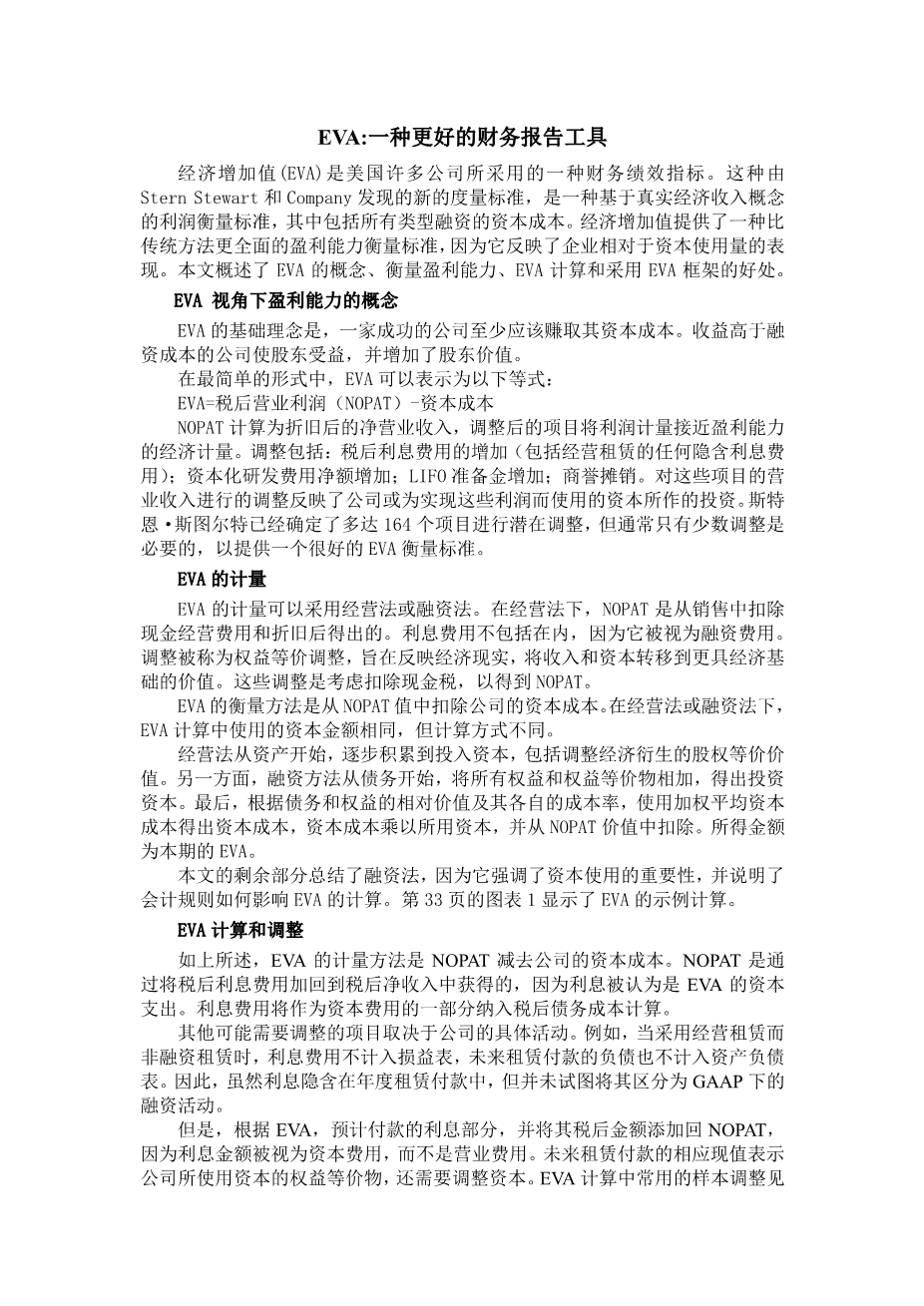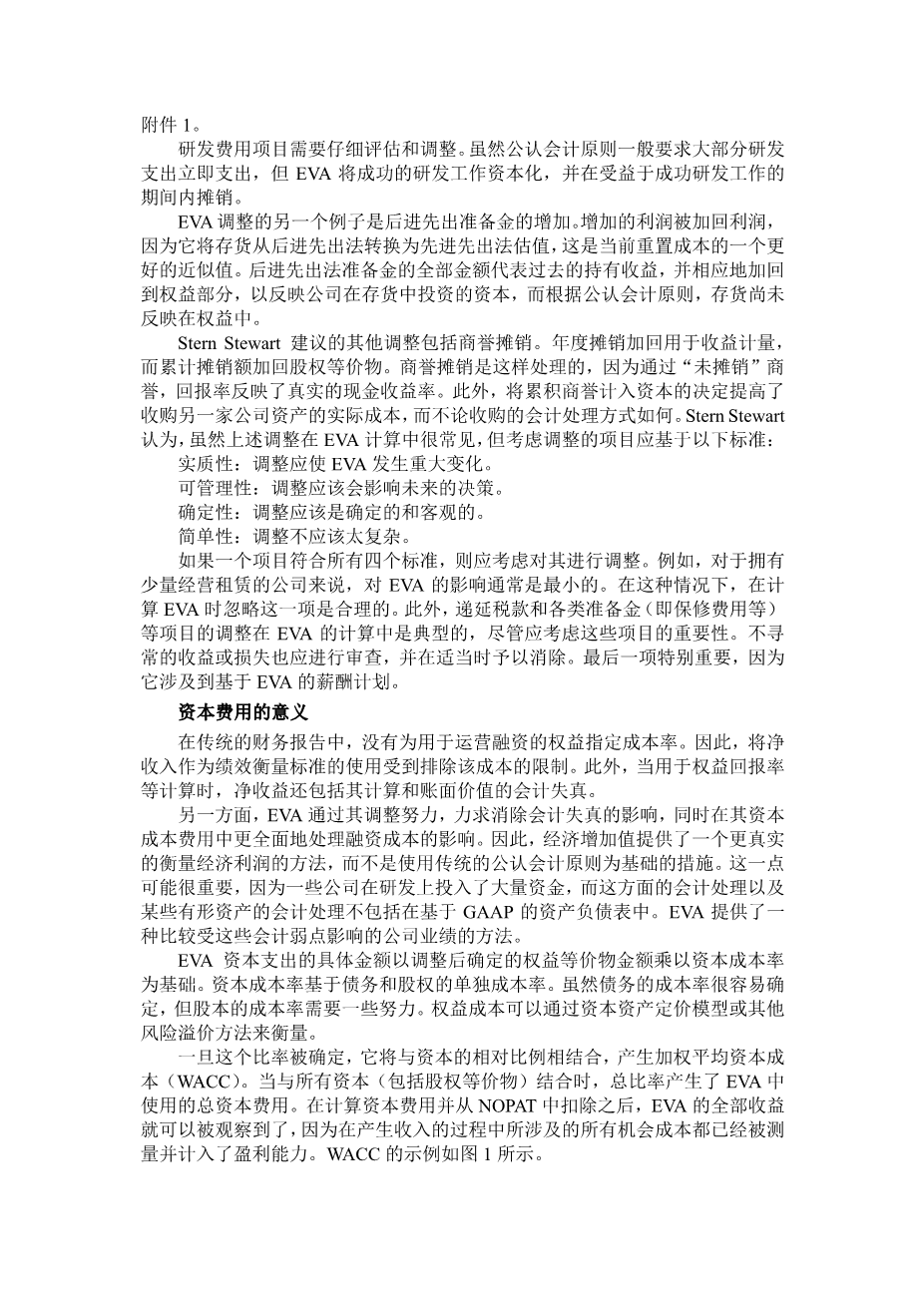EVA: A better financial reporting tool
Economic Value Added (EVA) is a financial performance measure being adopted by many companies in corporate America. This new metric, trademarked by Stern Stewart and Company, is a profit measure based on the concept of true economic income which includes the cost of capital for all types of financing. EVA provides a more comprehensive measure of profitability than traditional measures because it indicates how well a firm has performed in relation to the amount of capital employed. This article summarizes the EVA concept of measuring profitability, the EVA calculation and the benefits of adopting an EVA framework.
The EVA Concept of Profitability
EVA is based on the concept that a successful firm should earn at least its cost of capital. Firms that earn higher returns than financing costs benefit shareholders and account for increased shareholder value.
In its simplest form, EVA can be expressed as the following equation:
EVA = Operating Profit After Tax (NOPAT) - Cost of Capital
NOPAT is calculated as net operating income after depreciation, adjusted for items that move the profit measure closer to an economic measure of profitability. Adjustments include such items as: additions for interest expense after-taxes (including any implied interest expense on operating leases); increases in net capitalized Ramp;D expenses; increases in the LIFO reserve; and goodwill amortization. Adjustments made to operating earnings for these items reflect the investments made by the firm or capital employed to achieve those profits. Stern Stewart has identified as many as 164 items for potential adjustment, but often only a few adjustments are necessary to provide a good measure of EVA.[1]
Measurement of EVA can be made using either an operating or financing approach. Under the operating approach, NOPAT is derived by deducting cash operating expenses and depreciation from sales. Interest expense is excluded because it is considered as a financing charge. Adjustments, which are referred to as equity equivalent adjustments, are designed to reflect economic reality and move income and capital to a more economically-based value. These adjustments are considered with cash taxes deducted to arrive at NOPAT.
EVA is then measured by deducting the companys cost of capital from the NOPAT value. The amount of capital to be used in the EVA calculations is the same under either the operating or financing approach, but is calculated differently.
The operating approach starts with assets and builds up to invested capital, including adjustments for economically derived equity equivalent values. The financing approach, on the other hand, starts with debt and adds all equity and equity equivalents to arrive at invested capital. Finally, the weighted average cost of capital, based on the relative values of debt and equity and their respective cost rates, is used to arrive at the cost of capital which is multiplied by the capital employed and deducted from the NOPAT value. The resulting amount is the current periods EVA.
The remainder of this article summarizes the financing approach because it emphasizes the significance of capital employed and illustrates how accounting rules impact the calculation of EVA. Exhibit 1 on page 33 shows a sample calculation of EVA.
EVA Calculation and Adjustments
As stated above, EVA is measured as NOPAT less a firms cost of capital. NOPAT is obtained by adding interest expense after tax back to net income after-taxes, because interest is considered a capital charge for EVA. Interest expense will be included as part of capital charges in the after-tax cost of debt calculation.
Other items that may require adjustment depend on company-specific activities. For example, when operating leases rather than financing leases are employed, interest expense is not recorded on the income statement, nor is a liability for future lease payments recognized on the balance sheet. Thus, while interest is implicit in the yearly lease payments, an attempt is not made to distinguish it as a financing activity under GAAP.
Under EVA, however, the interest portion of the payment is estimated and the after-tax amount from it is added back into NOPAT because the interest amount is considered a capital charge rather than an operating expense. The corresponding present value of future lease payments represents equity equivalents for purposes of capital employed by the firm, and an adjustment for capital is also required. See Exhibit 1 for sample adjustments commonly used in the calculation of EVA.
Ramp;D expense items call for careful evaluation and adjustment. While GAAP generally requires most Ramp;D expenditures to be expensed immediately, EVA capitalizes successful Ramp;D efforts and amortizes the amount over the period benefiting the successful Ramp;D effort.
Another example of an EVA adjustment is the LIFO reserve increase. The increase is added back to profit because it converts inventory from a LIFO to FIFO valuation, which is a better approximation of current replacement cost. The full amount of the LI
剩余内容已隐藏,支付完成后下载完整资料
英语译文共 3 页,剩余内容已隐藏,支付完成后下载完整资料
资料编号:[258306],资料为PDF文档或Word文档,PDF文档可免费转换为Word
以上是毕业论文外文翻译,课题毕业论文、任务书、文献综述、开题报告、程序设计、图纸设计等资料可联系客服协助查找。




